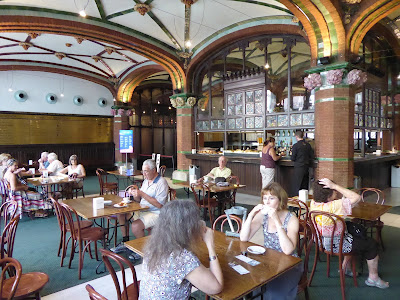Like all visitors to Barcelona, I came excited and ready to visit the buildings of the most famous local architect, Antonio Gaudi. However, I was delighted to discover these works by his contemporary, Lluis Domenich y Montaner, which are equally exciting and incredibly well crafted.
Right near our apartment, I found the Fundacio Antonio Tapies, which was originally built as a printing factory, but is now a museum of contemporary art, including the work of Tapies, who did the wire sculpture on the roof. It's right around the corner from the Casa Batllo by Gaudi, which was in my last post.
I went on a guided tour of the Palau de Musica de Catalunya, which is Domenich's most famous building, and was totally blown away. So much so that I got tickets to come back with Amy and our friend, Pudd, who has joined us here, to see a classical guitar concert later in the week. We saw a guy named David Russell, who was born in Scotland and raised in Spain, and he's one of the foremost classical guitarists in the world. His artistry totally blew us away. Not to mention how exciting it was to sit in this theater at night and look around at all the beauty.
The main entry is now through a new addition, done within the last ten years. They blew out the buildings across a small alley from the side wall of the theater to open up a plaza, and built a glass wall, seemingly suspended in front of the old facade of the building. During the day, you mainly see the glass, but at night the old facade shines through. Once inside, you get to this lovely cafe.
The balcony off the upstairs waiting room is one of the nicest, and most photographed, parts of the building. Every tiled column is different, and it has the beautifully framed window at the end.
Then we got to go into the theater itself. What can I say, but WOW. One of the most beautifully spaces I've ever experienced. Tile and sculpture everywhere, and the walls are all stained glass, as is the center of the ceiling.
I love having a zoom lens to let me really see some of the detail in a building like this. This is the drop in the main skylight over the auditorium.
I was so blown away by the Palau, that I made a special hike out to see this architect's largest project, the Hospital de St. Pau. It's a complex of more than 20 buildings, which is still serving as a state of the art medical facility in a contemporary addition at one end of the site. Most of the older buildings are now used as private offices, and some as a museum which visitors like me can tour. You enter through the main administration building, which is at the opposite end of a long diagonal street from the Sagrada Familia church, which will be featured in my next post.
Passing through the main building, you enter a beautifully landscaped plaza, flanked by separate buildings for patients with different diseases. All of these pavilions were designed as long narrow spaces with large windows on both sides for cross ventilation. They're all clad in tile, and have lots of natural light. They are connected by over a km of underground walkways so staff could get back and forth.
The detailing is again just amazing, with elaborate tile roofs and sculptural elements, stained glass, and beautiful brick work.
In the center is the surgical wing. Each of the main surgical suites has large curving glass windows which face north to bring in natural light. I wouldn't want to walk by through during a gory procedure!
This is the main stairway in the admin building. I looked up in awe and the beautiful ceiling.
And finally, another interior view in the main building. I just love the Modernista architecture from the turn of the last century. It's creative, and full of artistry by a wide range of crafts people. The imagination and joy is incredible.
And now for an architectural editorial comment, it saddens me that this joyful spirit was lost after the wars. The majority of buildings in Barcelona, once you get out of the central area, are bland 10 story apartment or office slabs, both in good and bad neighborhoods, and they have no character. The sense of street is lost in many areas, and the monotony is overwhelming. I'm excited to see that in the past 15 years or so, there has been a resurgence of creative design - some in renovation, some in new construction, which has brought more dynamic buildings to the city, but none of those capture the joy and excitement of materials that i found in these older buildings.












No comments:
Post a Comment